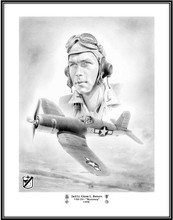 Loading... Please wait...
Loading... Please wait...- Home
- Combat Pilots/Pencil Drawings ~ Free Shipping
- Lt. Glenn L. Bowers ~ Free Shipping
Lt. Glenn L. Bowers ~ Free Shipping
Product Description
11" x 14" Print Size ~ Unlimited Print Edition
Lt. Glenn L. Bowers VMF-214Glenn Bowers graduated from William Penn (York) High School in 1939 and enrolled at Penn State, where he was a member of the Blue Band, Symphony, and Pi Kappa Alpha fraternity. In early 1941 he entered the Penn State's Civilian Pilot Training Program, soloing later that year and receiving his Private Pilot's License. After Pearl Harbor, he enlisted in the Navy as an aviation cadet and began active duty May 28, 1942 with a unit of 27 other Penn Staters. Upon completion of training at Corpus Christi, Texas, he was awarded the wings of a naval aviator and commissioned a 2nd Lieutenant in the Marine Corps in April 1943. After qualifying with required landings and takeoffs on an aircraft carrier, he was sent to the West Coast to await transport to the South Pacific as a replacement fighter pilot. In October 1943, he was assigned to the Black Sheep Squadron, VMF 214, which had already distinguished itself on its first combat tour. After a very brief training period flying a F4U Corsair, the Black Sheep returned to the combat area in November. He flew 28 combat missions with the Black Sheep squadron before it was pulled from combat in January 1944, having lost its leader, "Pappy" Boyington, in combat January 3,1944. Glenn flew 58 combat missions with two other fighter squadrons during the 13 months he was in the South Pacific. The Black Sheep Squadron was recognized with the Presidential Unit Citation and Glenn was awarded 11 air medals and three Distinguished Flying Crosses.
Warranty Information
null








